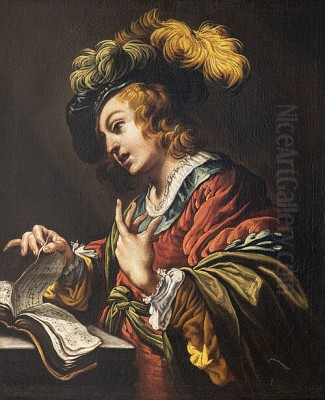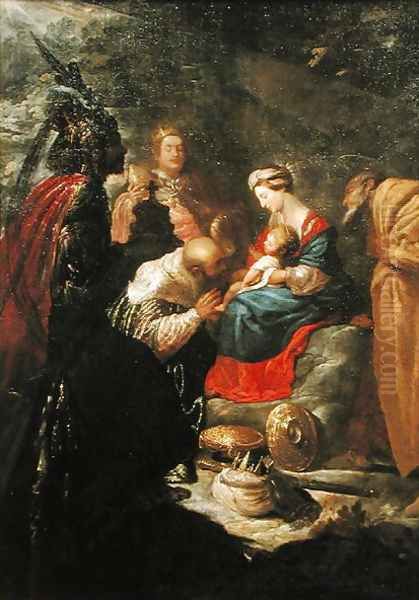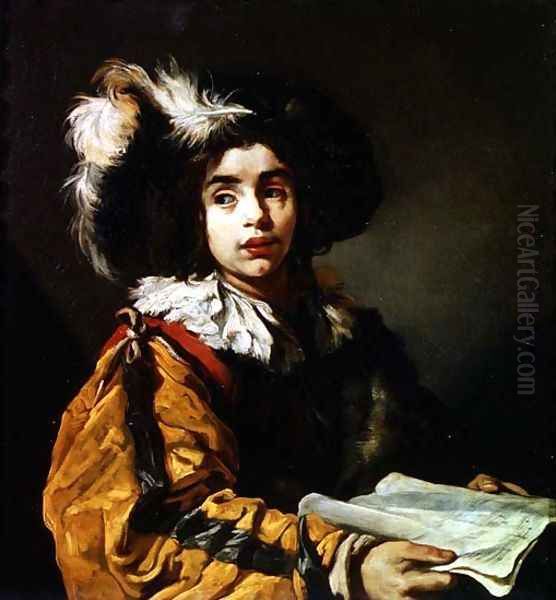
Claude Vignon stands as one of the most distinctive and prolific figures in seventeenth-century French art. Active as a painter, etcher, and illustrator, his long career spanned a period of significant artistic transformation in France. Born in Tours in 1593 and dying in Paris in 1670, Vignon navigated the complex currents of European art, absorbing influences from Italy, the Netherlands, and Germany, yet forging a highly personal and recognizable style. He was a contemporary of giants like Nicolas Poussin and Simon Vouet, yet his artistic path remained uniquely his own, characterized by vibrant color, dramatic lighting, and a penchant for rich textures and exotic details.
Early Life and Parisian Training
Claude Vignon was born into a prosperous family in Tours, a city with a rich cultural heritage. His family's comfortable circumstances likely provided him with the means to pursue an artistic career from a young age. He moved to Paris for his initial training, where tradition holds that he studied in the workshop of Jacob Bunel (c. 1558–1614). Bunel was a painter associated with the late Mannerist Second School of Fontainebleau, known for his work for the French monarchy, including decorations at the Louvre and Fontainebleau palaces.
This early exposure to the French artistic scene, still heavily influenced by the elegant, elongated forms and complex allegories of Mannerism, would form a foundational layer in Vignon's developing style. While Bunel's direct impact is difficult to trace precisely in Vignon's mature work, the apprenticeship would have provided essential technical skills in drawing, painting, and composition, preparing him for the next crucial phase of his artistic education.
The Transformative Roman Sojourn
Around 1609 or 1610, like many ambitious young artists of his generation, Vignon traveled to Rome. Italy, and particularly Rome, was the undisputed center of the art world, a place to study antiquities, Renaissance masters, and the revolutionary new styles emerging in the early Baroque period. This journey proved immensely formative for Vignon, exposing him to a vibrant international community of artists and profoundly shaping his artistic direction.

In Rome, Vignon associated with other young French painters, notably Simon Vouet (1590–1649) and Valentin de Boulogne (1591–1632). This circle was captivated by the powerful realism and dramatic lighting of Michelangelo Merisi da Caravaggio (1571–1610), whose influence permeated the Roman art scene even after his recent death. Vignon absorbed the lessons of Caravaggism, particularly the use of chiaroscuro – strong contrasts between light and shadow – to heighten drama and model form.
However, Vignon was never a slavish imitator. While in Rome, he also studied the works of other influential Italian masters. The rich colors and dynamic compositions of the Bolognese school, represented by Annibale Carracci (1560–1609) and his followers like Guido Reni (1575–1642) and Guercino (Giovanni Francesco Barbieri, 1591–1666), left a significant mark. Furthermore, the intense colors and meticulous detail found in the works of the German painter Adam Elsheimer (1578–1610), who was active in Rome during Vignon's stay, may also have resonated with him.
Vignon's Roman period, lasting until about 1616 or 1617, was a time of intense learning and synthesis. He developed a style that incorporated the dramatic intensity of Caravaggio but tempered it with a richer palette, more elaborate textures, and a lingering Mannerist elegance. His early masterpiece, the Martyrdom of Saint Matthew (1617), now in the Musée des Beaux-Arts d'Arras, exemplifies this fusion, showcasing powerful chiaroscuro alongside vibrant colors and expressive figures.
Return to Paris: Establishing a Career
Upon returning to Paris around 1616 or 1617, Vignon quickly established himself within the city's artistic milieu. He became a member of the Parisian painters' guild, the Maîtrise, which regulated the profession. In 1623, he married Charlotte de Leu, the daughter of the engraver Thomas de Leu, further integrating himself into the artistic and publishing world of the capital. This marriage marked the beginning of a period of significant professional success and personal expansion.
Vignon's distinctive style, blending Italianate drama with French sensibilities and a flair for the decorative, found favor with patrons. He received commissions from important figures, including King Louis XIII and the Queen Mother, Marie de' Medici. He also worked extensively for church patrons, creating altarpieces and religious scenes, as well as for private collectors who appreciated his historical, mythological, and allegorical subjects.
His studio became highly productive, and Vignon emerged as one of the most sought-after artists in Paris during the 1620s and 1630s. His ability to work across different genres – from large-scale religious narratives to intimate portraits and genre scenes – contributed to his widespread appeal. He navigated the Parisian art world successfully, building a reputation for both his artistic skill and his prolific output.
Artistic Style: An Eclectic Synthesis

Vignon's style is notoriously difficult to categorize neatly, often described as eclectic or idiosyncratic. He masterfully blended elements from various schools and periods, creating a unique visual language that set him apart from his contemporaries. His work represents a fascinating bridge between late Mannerism, the dramatic naturalism of Caravaggism, and the burgeoning French Baroque.
Mannerist Echoes
Traces of his early exposure to Mannerism persisted throughout his career. This can be seen in the sometimes elongated proportions of his figures, the complex, often crowded compositions, and a certain artificiality or theatricality in poses and gestures. Unlike the classical restraint favored by artists like Poussin, Vignon embraced a more decorative and expressive approach, reminiscent of the Fontainebleau school or even Northern Mannerist traditions.
Caravaggesque Foundations
The impact of Caravaggio and his followers remained fundamental to Vignon's art, particularly in his use of light and shadow. He employed strong chiaroscuro to create dramatic focus, model forms with solidity, and enhance the emotional intensity of his scenes. However, his interpretation of Caravaggism differed from that of artists like Valentin de Boulogne. Vignon's shadows are often less deep, his overall palette brighter and more varied, and his handling of paint often more textured and painterly. He adapted the Caravaggesque idiom to suit his own expressive and decorative aims.
Venetian and Northern Influences
Vignon's love for rich colors, opulent fabrics, gleaming metals, and sparkling jewels points towards influences beyond Caravaggism. The vibrant palette and emphasis on texture recall the Venetian tradition, particularly masters like Titian (c. 1488/90–1576) and Paolo Veronese (1528–1588), known for their sumptuous depictions of materials. There's also a connection to Northern European art, perhaps Dutch painters like Rembrandt (1606–1669) in the textured application of paint (impasto) and fascination with exotic costumes and character types, or Flemish masters like Peter Paul Rubens (1577–1640) in the dynamic energy of some compositions. Vignon seemed particularly drawn to depicting luxurious surfaces, rendering silks, velvets, gold embroidery, and gemstones with palpable delight.
Evolution of Style
Over his long career, Vignon's style continued to evolve. While the core elements remained consistent, his later works sometimes show a lightening of the palette and a looser, more fluid brushwork. The intense drama of his earlier, more overtly Caravaggesque paintings might give way to compositions that emphasize decorative richness and narrative complexity. Works like the Adoration of the Magi (1624-1626, Musée Rolin, Autun) or Croesus Showing Solon His Treasures (c. 1629, Musée des Beaux-Arts, Tours) exemplify his mature style, balancing dramatic lighting with intricate detail and vibrant color.
Master Etcher and Illustrator
Beyond his significant achievements as a painter, Claude Vignon was also a highly accomplished and prolific etcher. He embraced the medium with enthusiasm, producing hundreds of prints that circulated widely and contributed significantly to his fame and influence. His activity as a printmaker places him alongside other major figures of seventeenth-century French printmaking, such as Jacques Callot (1592–1635) and Abraham Bosse (1604–1676).
Vignon's etchings often mirrored the subjects of his paintings – religious scenes, historical episodes, allegories, and character studies. He possessed a fluid, expressive line in his etchings, capturing light effects and textures with remarkable skill. His prints were not merely reproductions of his paintings but original works of art, demonstrating his mastery of the specific possibilities of the etching medium.
He frequently collaborated with Parisian publishers, most notably François Langlois, known as "Ciartres" (or "Chartres"), a key figure in the print trade. Vignon provided designs for book illustrations, frontispieces, and individual prints, contributing to the visual culture of his time. His involvement in the publishing world underscores his versatility and entrepreneurial spirit. His prints helped disseminate his compositions and style across France and Europe, reaching a broader audience than his paintings alone could.
Notable Works and Commissions
Vignon's vast oeuvre includes numerous significant works housed in museums and churches across France and internationally. His paintings often depict dramatic moments from the Bible, lives of saints, ancient history, or mythology, rendered with his characteristic blend of realism and theatricality.
Key Paintings
The Martyrdom of Saint Matthew (1617, Musée des Beaux-Arts, Arras): An early masterpiece demonstrating his absorption and adaptation of Caravaggesque drama during his Roman period.
The Adoration of the Magi (1624-1626, Musée Rolin, Autun): A prime example of his mature style, showcasing rich colors, detailed textures, exotic figures, and a complex, dynamic composition.
The Young Singer (c. 1622-1623, Musée du Louvre, Paris): A charming and popular work, often seen as embodying the Caravaggesque interest in genre scenes, yet rendered with Vignon's typical vibrancy and attention to costume.
Saint Catherine Refusing to Worship Pagan Idols (c. 1620, Musée des Beaux-Arts, Grenoble): Demonstrates his skill in depicting strong female protagonists and dramatic narrative moments.
Croesus Showing Solon His Treasures (c. 1629, Musée des Beaux-Arts, Tours): A historical subject treated with Vignon's characteristic emphasis on opulence, exoticism, and psychological interaction.
Christ Washing the Feet of the Apostles (Notre Dame Cathedral, Paris - location/status may vary): Vignon received important commissions for Parisian churches, including Notre Dame, contributing significantly to the religious art of the capital.
Saint Anthony Abbot and Saint Paul the Hermit (various versions): Vignon frequently depicted hermit saints, exploring themes of piety, contemplation, and the wilderness, often with expressive realism. Examples can be found in churches like Saint-Gervais-Saint-Protais in Paris.
Portraits: While less numerous than his narrative works, Vignon also painted portraits, such as the Portrait of a Young Man (Musée du Louvre), capturing individual likeness with psychological insight.
Major Commissions
Vignon's success brought him significant commissions throughout his career. He contributed paintings to major decorative cycles in Parisian churches, including Notre Dame, Saint-Nicolas-des-Champs, and Saint-Gervais-Saint-Protais. His work for royal patrons, Louis XIII and Marie de' Medici, further cemented his status. He also undertook decorative work for private residences, such as the reported (though debated) collaboration with Anne Geneviève de Bourbon, Duchess of Longueville, at the Château du Thorigny.
Later Life, Family, and the Academy
Vignon's personal life was as full as his professional one. After the death of his first wife, Charlotte de Leu, he married Geneviève Ballard in 1644. Across his two marriages, he reputedly fathered a remarkable number of children – tradition often cites twenty-four or even more, though precise numbers are hard to verify. This large family included several children who followed him into artistic professions, notably his sons Claude Vignon the Younger (c. 1633–1703) and Philippe Vignon (1638–1701), who became painters themselves.
Despite his established success outside official structures, Vignon became one of the founding members of the French Royal Academy of Painting and Sculpture (Académie Royale de Peinture et de Sculpture) in 1648. This institution, championed by figures like Charles Le Brun (1619–1690), aimed to elevate the status of artists and impose a more centralized, classically oriented artistic doctrine. Vignon's inclusion among the "anciens" (elders) at its founding reflects his established reputation, even if his eclectic style differed from the increasingly dominant classicism promoted by Le Brun.
He remained active and productive into his later years, continuing to paint and etch. Claude Vignon died in Paris in 1670, at the age of 77, leaving behind an extensive and diverse body of work.
Contemporaries and Artistic Context
To fully appreciate Vignon's unique position, it is helpful to consider him within the broader context of seventeenth-century French art. He worked during a period often referred to as the "Grand Siècle" (Great Century), which saw Paris rise as a major European cultural capital.
His contemporaries included artists pursuing different stylistic paths. Simon Vouet, his former companion in Rome, returned to Paris in 1627 and introduced a lighter, more decorative Baroque style that became highly influential. Nicolas Poussin (1594–1665), though spending most of his career in Rome, became the paragon of French Classicism, emphasizing order, reason, and drawing. Philippe de Champaigne (1602–1674) developed a sober, realistic style, particularly renowned for his portraits and austere religious works influenced by Jansenism.
Other notable figures included Georges de La Tour (1593–1652), a provincial master known for his dramatic nocturnal scenes and candlelit chiaroscuro, representing a distinct strand of French Caravaggism. Laurent de La Hyre (1606–1656) and Eustache Le Sueur (1616–1655) developed a gentler, more lyrical form of classicism often termed "Atticism."
Compared to these contemporaries, Vignon stands out for his stylistic independence and his synthesis of diverse influences. While Vouet moved towards a lighter Baroque and Poussin championed classicism, Vignon retained elements of Mannerism and a more intense, sometimes darker, palette derived from his Caravaggesque and Northern interests. He was less concerned with theoretical purity than with expressive effect and decorative richness.
Legacy and Influence
Claude Vignon's legacy is complex. During his lifetime, he was highly successful and influential, particularly through his paintings and widely circulated prints. His distinctive style, characterized by its energy, rich textures, and dramatic flair, offered an alternative to the more restrained classicism that gained prominence later in the century under the influence of Le Brun and the Academy.
His direct influence on major subsequent painters might be considered limited compared to figures like Vouet or Poussin. The dominant trend in French art moved towards a more formalized classicism, somewhat eclipsing Vignon's more eclectic and individualistic approach. However, his importance as a printmaker remained significant, and his works continued to be appreciated by collectors.
In modern times, there has been a renewed appreciation for Vignon's unique contribution to French Baroque art. Art historians recognize the originality of his stylistic synthesis, his technical brilliance, particularly in rendering textures, and the sheer imaginative power of his work. He is no longer seen merely as a peripheral figure but as a major independent master who carved his own path through the rich artistic landscape of seventeenth-century France. His prolific output and distinctive style ensure his place as a fascinating and important artist of the period.
Conclusion
Claude Vignon was a force of nature in seventeenth-century French art. A painter, etcher, and illustrator of remarkable energy and versatility, he absorbed influences from across Europe – Italian Caravaggism and Bolognese color, Northern realism and texture, and French Mannerist elegance – forging them into a highly personal and instantly recognizable style. His work pulses with dramatic intensity, vibrant color, and a fascination with the exotic and the opulent. While perhaps less doctrinally pure than some of his contemporaries, Vignon's art offers a compelling vision, rich in narrative power and visual delight. His extensive oeuvre remains a testament to a long, productive career dedicated to exploring the expressive possibilities of painting and printmaking, securing his position as an eclectic but essential master of the French Baroque.